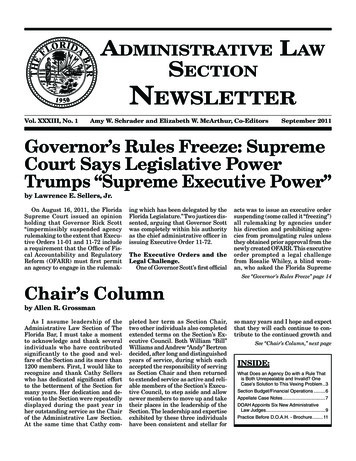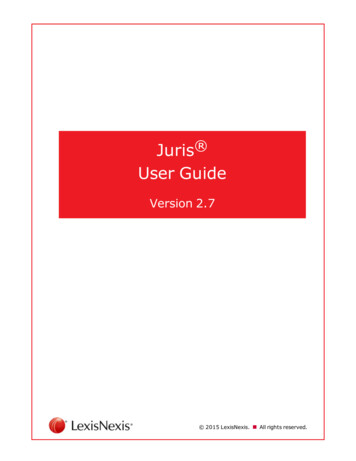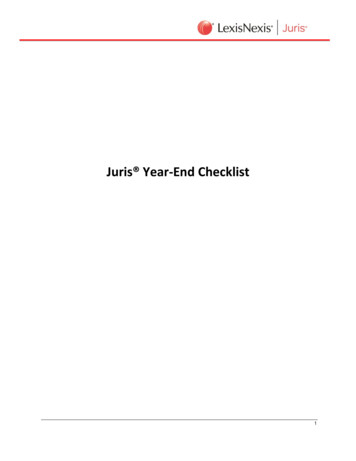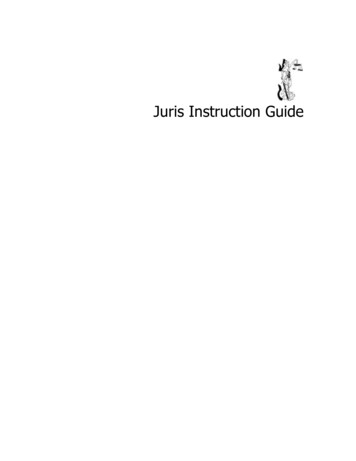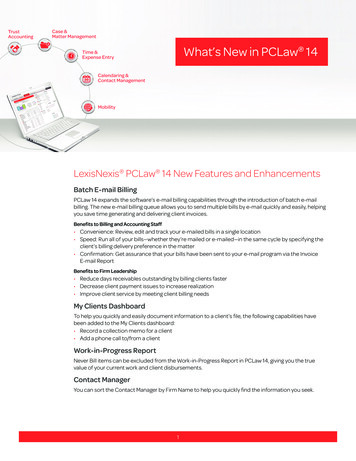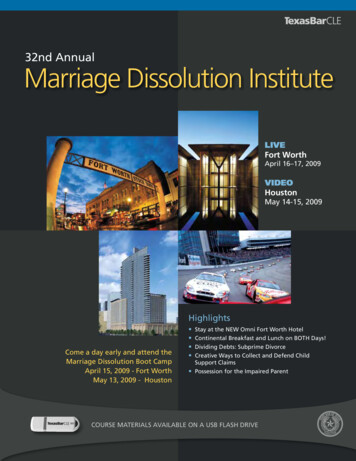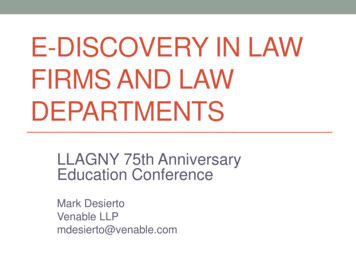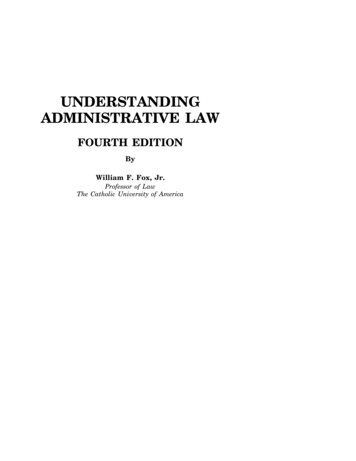
Transcription
0001VERSACOMP (4.2 ) – COMPOSE2 (4.41)NEW LAW SCH. Front Matter SAMPLE for PERFECTBOUND PubsJ:\VRS\DAT\00878\FM.GML --- PERF FM.STY --- POSTUNDERSTANDINGADMINISTRATIVE LAWFOURTH EDITIONByWilliam F. Fox, Jr.Professor of LawThe Catholic University of America09/04/03 (10:21)1
0002VERSACOMP (4.2 ) – COMPOSE2 (4.41)NEW LAW SCH. Front Matter SAMPLE for PERFECTBOUND PubsJ:\VRS\DAT\00878\FM.GML --- PERF FM.STY --- POSTThis publication is designed to provide accurate and authoritative information in regard to the subjectmatter covered. It is sold with the understanding that the publisher is not engaged in rendering legal,accounting, or other professional services. If legal advice or other expert assistance is required, theservices of a competent professional should be sought.LexisNexis and the Knowledge Burst logo are trademarks of Reed Elsevier Properties Inc, used underlicense. Matthew Bender is a registered trademark of Matthew Bender Properties Inc.Copyright 2000 Matthew Bender & Company, Inc., a member of the LexisNexis Group.All Rights Reserved.No copyright is claimed in the text of statutes, regulations, and excerpts from court opinions quotedwithin this work. Permission to copy material exceeding fair use, 17 U.S.C. § 107, may be licensedfor a fee of 10 per page per copy from the Copyright Clearance Center, 222 Rosewood Drive,Danvers, Mass. 01923, telephone (978) 750-8400.ISBN#:Library of Congress Cataloging-in-Publication DataFox, William F.Understanding Administrative Law/William F. Fox, Jr.—4th ed.p. cm.— (Legal text series)Includes bibliographical references and index.ISBN 0–8205–4727–11. Administrative law—United States. 2. Administrative procedure—United States. I. Title. II. Series.KF5402.F68 2000342.73’06—dc2100-056429Editorial Offices744 Broad Street, Newark, NJ 07102 (973) 820-2000201 Mission St., San Francisco, CA 94105-1831 (415) 908-3200701 East Water Street, Charlottesville, VA 22902-7587 (804) 972-7600www.lexis.com(Pub.878)09/04/03 (10:21)11
Chapter 1, Introduction, is reproduced fromUnderstanding Administrative Law, Fourth Edition, byWilliam F. Fox, Jr., Professor of Law, The CatholicUniversity of America. Copyright 2000 MatthewBender & Company, Inc., a member of the LexisNexisGroup. All rights reserved.A user is hereby granted the right to view, print ordownload any portion of this sample chapter, so long as itis for the User's sole use. No part of this sample chaptermay be sold or distributed by the User to any person inany form, through any medium or by any means.
0001VERSACOMP (4.2 ) – COMPOSE2 (4.41)09/19/03 (11:28)J:\VRS\DAT\00878\1.GML --- r878.STY --CTP READY-- v2.8 2/21 --- POSTIntroduction§ 1.01 Introduction[A]—Overview of Administrative LawIn the broadest sense, administrative law involves the study of how thoseparts of our system of government that are neither legislatures nor courtsmake decisions. These entities, referred to as administrative agencies, arenormally located in the executive branch of government and are usuallycharged with the day–to–day details of governing. Agencies are created andassigned specific tasks by the legislature. The agencies carry out these tasksby making decisions of various sorts and supervising the procedures bywhich the decisions are carried out. For example, Congress has chargedthe federal Social Security Administration (SSA) with the administrationof the nation’s social security program. Under that mandate, SSA does twothings: (1) it makes general social security policy (within the terms of thestatute, of course) and (2) it processes individual applications for, andterminations of, social security benefits. Affected persons who disagree withthe agency’s decisions on either the substance of the social security programor the procedures under which that program is implemented—and whosegrievances are not resolved within the agency—are permitted to take theirdispute into federal court for resolution. Occasionally, aggrieved personsreturn to the legislative branch in an attempt to persuade Congress to alterthe statute under which the social security program functions.This brief outline is the basic model for the American administrativeprocess; and whether you are studying federal administrative law, a stateadministrative system, or even a single administrative agency, the processof decision–making is likely to be similar, even when the missions of theagencies differ. It is the unifying force of the administrative process—in1(Pub. 878)11/1
0002VERSACOMP (4.2 ) – COMPOSE2 (4.41)09/19/03 (11:28)J:\VRS\DAT\00878\1.GML --- r878.STY --CTP READY-- v2.8 2/21 --- POST2UNDERSTANDING ADMINISTRATIVE LAW§ 1.01dramatic contrast to the wide variety of substantive problems with whichagencies deal—that has persuaded most administrative law professors toconcentrate on agency procedure rather than agency substance. Accordingly,most contemporary administrative law courses analyze the manner in whichmatters move through an agency, rather than the wisdom of the mattersthemselves. In other words, the manner in which the federal Departmentof Transportation decided to impose a passive–restraint system on automobile manufacturers is a fascinating case history of the administrative process,irrespective of anyone’s personal position on the wisdom of air bags versusseat belts. Recognizing that the focus of most administrative law coursesis on how decisions are made (rather than what those decisions are) shouldhelp you more readily understand the themes of the typical course inadministrative law. 1[B]—Approaches to the Study and Practice of Administrative LawAdministrative law can be approached in much the same fashion as manyother law school courses. If you regard the field merely as a collection ofdiscrete legal doctrines, it may make a great deal of sense simply tomemorize various general principles, to apply those principles to a finalexamination or a bar examination, and then forget about the topic. Thisbook can be used in that fashion. A more profitable approach, however,to truly understanding administrative law—and for practicing administrativelaw after your admission to the bar—is to keep two questions in mind fromthe beginning: (1) What are the rules of the game, both substantive andprocedural? and (2) How may I best represent my client before anadministrative agency? Thinking through the twin issues of doctrine andthe application of that doctrine through the lawyering process will makeyou a much better lawyer, even if it doesn’t necessarily have an immediatepayoff in your law school course or on the bar examination. 2The administrative law course will become less fuzzy if you keep in minda few more fundamentals. First, under our constitutional system, agenciesare creatures of the legislature. They do not spring up on their own, andthey cannot be created by courts. Agencies function only insofar as a1 One respected casebook disagrees with this approach and postulates that administrativelaw can be properly understood only if one studies an individual agency in depth, bothsubstantively and procedurally. Glen O. Robinson, Ernest Gellhorn, & Harold H. Bruff, THEADMINISTRATIVE PROCESS (4th ed. 1993).2 Administrative law questions on the bar examination tend to be very much like lawschool examination questions. Practitioners will find additional hints on practicing beforefederal agencies in William Fox, Some Considerations in Representing Clients BeforeFederal Agencies, Law Practice Notes (Barrister Magazine, ABA) 21–26 (Summer, 1981).(Pub. 878)141/1
0003VERSACOMP (4.2 ) – COMPOSE2 (4.41)09/19/03 (11:28)J:\VRS\DAT\00878\1.GML --- r878.STY --CTP READY-- v2.8 2/21 --- POST§ 1.01INTRODUCTION183legislature has given them the authority to function. That authority may beexceptionally broad (e.g., telling an agency to regulate railroads by applyingthe standard of “public convenience and necessity”) or incredibly narrow(e.g., when Congress sets the specific income levels and other criteria forthose persons who qualify for certain government benefits; or whenCongress passes a Coal Mine Safety and Health Act, containing provisionsthat tell mine operators what size of mine roofing bolts to install).Federal administrative agencies are typically endowed with broad, generalpowers. By contrast, state legislatures often enact far more detailed agencystatutes because of a lingering reluctance to give state agencies unfetteredpower. For example, the Nebraska legislature once enacted a statuteprescribing the thickness of the metal walls in milk cans, presumablybecause the legislature did not trust the relevant administrative agency tomake a sound decision on this issue. This kind of statutory detail frequentlysignals a legislature’s distrust with one agency in particular, or, possibly,with the administrative process in general. It is much less common for theUnited States Congress to get bogged down in the minutiae of administeringa particular federal regulatory program because Congress tends to have moreconfidence in the federal agencies.Whatever form a new administrative agency takes, the legislature mustenact a statute creating the agency. This statute, sometimes called anagency’s organic act but more frequently referred to as an agency’senabling act, is the fundamental source of an agency’s power. Thisprinciple—that the legislature creates agencies and sets limits on theirauthority—should be regarded as cardinal rule number one of administrativelaw. Far too many people in law school and, on occasion, even experiencedpractitioners, lose sight of this fundamental principal. A misunderstandingof this basic concept can lead to erroneous assumptions about an agency’sability to deal with a particular issue or problem.Some enabling acts contain specific provisions establishing agencyprocedures; but more often than not, when the legislature creates an agency,that agency acquires a specific substantive mission but derives its procedures from a more general statute setting out procedural requirements forall agencies sharing its jurisdiction. The governing procedural statute at thefederal level is the Administrative Procedure Act (APA), 3 in place since1946 and normally the thread that holds most law school administrativelaw courses together. While state administrative procedure statutes differconsiderably, a prototype statute, the Model State Administrative ProcedureAct, 4 has been promulgated; and many states either have adopted the Model345 U.S.C. §§ 551 to 808. See Appendix A.See Appendix B.(Pub. 878)3/3
0004VERSACOMP (4.2 ) – COMPOSE2 (4.41)09/19/03 (11:28)J:\VRS\DAT\00878\1.GML --- r878.STY --CTP READY-- v2.8 2/21 --- POST4UNDERSTANDING ADMINISTRATIVE LAW§ 1.01Act in toto or incorporated substantial portions of it into their existingadministrative procedure statutes. Thus, you are likely to find at least someprocedural uniformity among the states. Those students whose coursesemphasize a single state’s administrative system would do well to makeconstant reference to that state’s administrative procedure act as they workthrough their course and this book. They will probably see many similaritiesbetween the state act and the federal APA. 5Some law professors understandably disagree with a purely federalapproach to understanding administrative law. Professor Arthur Bonfieldof the University of Iowa College of Law believes that a proper study ofthe state administrative process would pay large dividends for both studentsand professors. He believes, among other things, that administrative lawis best appreciated through a comparative approach to the topic, that thereis a great deal of creativity (what he calls “state solutions”) in stateadministrative systems that are never implemented by the stodgier, lessinnovative federal agencies, and, perhaps most importantly:State administrative processes operate under different circumstancesthan does the federal administrative process; consequently, some ofthe problems presented [in the states] differ either in degree or kindfrom those presented in the federal process. Many of the feasible oreffective solutions to federal administrative law problems are notfeasible or effective in the state context. Therefore, a study of problemsand solutions in the federal administrative process cannot be anadequate vehicle to prepare students for dealing with all of the majorproblems presented in the state administrative process. 6No matter how a legislature chooses to deal with an agency, your firsttask is simple: Read the agency’s enabling act and that jurisdiction’sadministrative procedure act. One way to create a lot of trouble for yourself,even at the beginning of the course, is to be casual about reading the5 See, e.g., William Fox & Leonard Carson, A Comparison of the Florida and FederalAdministrative Procedure Acts, 11 Florida Bar Journal 699 (1980). Florida has more recentlyengaged in a great deal of administrative reform. Jim Rossi, The 1996 Revised FloridaAdministrative Procedure Act: A Survey of Major Provisions Affecting Florida Agencies,24 Fla. St. U. L. Rev. 283 (1997).6 Arthur E. Bonfield, State Law in the Teaching of Administrative Law: A Critical Analysisof the Status Quo, 61 Tex. L. Rev. 95, 103–04 (1982). More recently, Professor Peter Strausshas suggested that administrative law is one of the “hidden” comparative law courses inlaw school because it combines and requires comparisons between a large number of otherlaw school courses. Peter L. Strauss, Administrative Law: The Hidden Comparative LawCourse, 46 J. Legal Educ. 478 (1996).(Pub. 878)215/5
0005VERSACOMP (4.2 ) – COMPOSE2 (4.41)09/19/03 (11:28)J:\VRS\DAT\00878\1.GML --- r878.STY --CTP READY-- v2.8 2/21 --- POST§ 1.01INTRODUCTION245applicable statutes. Reading and trying to understand the statutes shouldbe regarded as cardinal rule l–A for understanding administrative law.Agencies make a great deal of policy within the boundaries of theirenabling acts. Within the boundaries of their administrative procedure act,they also establish procedures for efficient and fair decision–making.Remember that enabling acts and administrative procedure acts oftenestablish only minimum standards and requirements for individual agencies.These statutes are often so broadly phrased that agencies have enormousleeway to fill in the gaps—both procedural and substantive—of thelegislation so long as they keep within the terms of the governing statutes.The areas in which many agencies are free to set their own policies andprocedures are quite extensive. We refer to this freedom of action as agencydiscretion. Agency discretion is a second fundamental to keep constantlyin mind.Unfortunately, the concept of agency discretion is one of the least studiedand most poorly understood aspects of administrative law. It is so littleanalyzed that it is frequently referred to as “the hidden component” ofadministrative law. Nevertheless, it is a phenomenon that both students andpractitioner need to appreciate if they are to have a complete understandingof an agency. The first step is realizing that the vast majority of agencydecisions are never reviewed by either the courts or the legislature. Otherparts of the executive branch, such as the president, governor or attorneygeneral, occasionally get involved with agency action, but for the most partagencies function on their own, often with only sporadic outside scrutinyand accountability.A third fundamental that should never be forgotten is that courts havea relatively limited role in supervising agency conduct. These days, thefederal courts, and many state courts, are required to take what amountsto a “hands off” attitude toward the agencies. The days when a free–wheeling court could substitute its judgment in a dispute for that of theagency are largely over, irrespective of whether the issue before the courtis substantive or procedural. The United States Supreme Court has beenhammering this message home to the lower federal courts for years. 7 Manystate courts are beginning to adopt a similar posture.This is not to say that judicial review of agency action is unimportant.As we will see, in many cases it is the tail that wags the dog. But the merefact that a case might be taken to court is no excuse for sloppy lawyeringat the agency level. Too many lawyers make the fatal mistake of thinking7 See, e.g., Vermont Yankee Nuclear Power Corp. v. Natural Resources Defense Council,Inc. (NRDC), 435 U.S. 519 (1978) discussed in Chapter 7, § 7.03.(Pub. 878)7/7
0006VERSACOMP (4.2 ) – COMPOSE2 (4.41)09/19/03 (11:28)J:\VRS\DAT\00878\1.GML --- r878.STY --CTP READY-- v2.8 2/21 --- POST6UNDERSTANDING ADMINISTRATIVE LAW§ 1.02that a reviewing court will correct any and all mistakes in the proceedingsbelow, or, indeed, that a court has plenary review powers over agencyaction. That is simply not the case. The ability of a court to change anagency decision is so limited these days that the second cardinal rule foragency practice is: A lawyer must win a case at the agency or likely willnot win it at all. 8 A legislative solution for your client’s problem may betheoretically possible, but you should remain realistic about actuallyachieving a favorable result. Try to avoid too much wishful thinking.§ 1.02 Nature of Administrative Agencies[A]—Addressing Legal DisputesThere is hardly any function of modern government that does not involve,in some way, an administrative agency. The reason for this is really verysimple: agencies are the only government entities equipped to deal withthe day–to–day minutiae of governing. It is one thing for Congress to decideto regulate trucking companies, but the last thing that Congress wants todecide is how much Company X may charge to carry a package from NewYork to Chicago. Rigorous protection of the environment is now a matterof national consensus, but a court is unlikely to have the technical expertisenecessary to decide precisely which specific air pollution control equipmentis best suited for coal–fired power plants. Two themes which continuallyrepeat in administrative law in regard to the purpose for the establishmentof agencies are: (1) oversight of the detail of regulation and (2) developmentof expertise in a particular area of regulation.Understanding the nature of administrative agencies first requires ananalysis of the way in which disputes are typically addressed by our legalsystem. Consider, for example, the case of a creative business executive8 The author recognizes that this statement really goes out on a limb. Many readers, bothlawyers and students, will throw back all sorts of instances when courts overturned agencyaction. That’s true, but whether one addresses this issue by analyzing the doctrinal limitationsplaced on judicial review or merely looks at the statistics (i.e., the number of all agencydecisions overturned by courts), he or she will find that the vast bulk of agency decisionsare either never taken to court or are simply affirmed when they get there. Thus, the messageof cardinal rule number two should not be forgotten: cases are normally won or lost at theagency. Courts usually are not the answer nor is the legislature. However, lawyers shouldnot ignore the possibility of a legislative solution. If agencies are creatures of statute, oneof the most effective places to turn for relief—at least on a prospective basis—is thelegislature. But here again, a wise practitioner will consider whether the legislature will payany attention to the grievance. Most legislatures are far too busy with more generic issuessuch as budget and taxes. They are often reluctant to involve themselves in the detail ofgovernment.(Pub. 878)288/8
0007VERSACOMP (4.2 ) – COMPOSE2 (4.41)09/19/03 (11:28)J:\VRS\DAT\00878\1.GML --- r878.STY --CTP READY-- v2.8 2/21 --- POST§ 1.02INTRODUCTION357who sees a need for privately–owned rocketships serving various industrialand commercial purposes. 9 One option for the business executive underour system of government is simply to start building and flying rocketswithout worrying about the consequences of accidents and without seekinganyone’s permission to do so. It is possible, but hardly likely, that onlygood things will occur and nothing bad will ever happen. However, a wiseentrepreneur always considers the potential liability of a businessundertaking.In a legal system such as ours and given no specific regulatory controlson this type of business, if some incident does occur, and if there is nothingspecific in the law books governing rocket accidents, the common law cangrapple with any disputes that arise through the application of generalprinciples of tort or contract liability. For example, the nineteenth centuryBritish courts had no trouble dealing with a water storage tank that brokeand flooded some nearby property, even though Parliament had neverspoken on the issue, and even though no previous court had addressed theproblem. Principles drawn from tort law, because injury to a propertyinterest was involved, enabled the court to dispose of both the issue ofliability and the issue of remedy, even though it was a case of firstimpression. 10 Common law dispute resolution is triggered by any injuredperson who feels strongly enough about his or her injury to file a formalaction in court and who has a strong enough case to convince the courtthat liability exists and that some type of monetary relief ought to be granted.Applying the common law solution to our hypothetical indicates that thecumulative effect of reported decisions will eventually establish a body oflegal rules for the construction and operation of private rockets without anyother government action. Of course, these rules may be overly–narrow ortoo sketchy to give comprehensive guidance on how an entrepreneur oughtto proceed. Still, many problems in our society are handled precisely inthis fashion, and it is not necessarily a bad way to handle disputes. Thecommon law solution is flexible enough to react to changing circumstancesand predictable enough to give people at least a little warning before theyget into trouble.Looking at the problem realistically, however, a business executive willlikely want more predictability and stability than the common law systemoffers. It is highly doubtful, for example, whether a bank would lend ourexecutive any money for a wholly–untried activity such as this without morein the nature of protection from liability. One option would be to go to9This hypothetical was suggested by a problem on rainmaking contained in Walter Gellhorn, Clark Byse and Paul Verkuil, ADMINISTRATIVE LAW PROBLEMS (1974).10 Rylands v. Fletcher, 3 Eng. Rep. (H.L.) 330 (1823).(Pub. 878)9/9
0008VERSACOMP (4.2 ) – COMPOSE2 (4.41)09/19/03 (11:28)J:\VRS\DAT\00878\1.GML --- r878.STY --CTP READY-- v2.8 2/21 --- POST8UNDERSTANDING ADMINISTRATIVE LAW§ 1.02a legislature for assistance. Armed with enough political clout, the executivemight persuade the legislature simply to authorize the activity. In otherwords, the legislature could pass a statute saying: “Private corporations maybuild and operate rocketships.” If this did not satisfy the executive, shemight persuade the legislature to expressly permit the activity and to seta cap on possible liability stemming from any accidents involving theprivate rockets. 11 But a legislature’s reaction is frequently unpredictable.Rather than approving private rocketry, the legislature could decide thatthe activity is so fraught with danger and with hidden social and economiccosts that it flatly prohibits private rocket development. The legislaturemight even go so far as to impose criminal penalties on anyone who attemptsto operate a private rocket. Legislative prohibitions of this type don’t occurall that often, but readers may recall that cocaine was once sold to theAmerican public on an over–the–counter basis and once was a primaryingredient in a still–popular soft drink.[B]—Legislative ChoicesThe legislature has even more alternatives in dealing with the rocketshipbuilder. It might decide that the problem should be dealt with by settingup some kind of government agency. Here, the choices range over a broadspectrum. In making these choices, a legislature will typically analyze:1. The task to be assigned to the agency (often referred to as theagency’s “mission”). There are two factors that are usually consideredin this analysis:a.what is the nature of the specific business or industry to be regulated(e.g., firms manufacturing drugs, firearms or rockets); andb.in what manner should the regulation be carried out (by licensing,monitoring, or performing the actual work at issue);2. The way the agency should be structured (whether, for example,it is to be headed by a single administrator or by a multi–personcommission and what its internal organization will be); and3. The placement of the agency within the existing system ofgovernment (e.g., whether it is to be a separate cabinet–level agency,a component of an existing agency or an independent regulatorycommission).11 For example, the Price–Anderson Act, 42 U.S.C. § 2210(c), sets a cap of 560 millionon any accident occurring in a civilian nuclear powerplant.(Pub. 878)3711/11
0009VERSACOMP (4.2 ) – COMPOSE2 (4.41)09/19/03 (11:28)J:\VRS\DAT\00878\1.GML --- r878.STY --CTP READY-- v2.8 2/21 --- POST§ 1.02INTRODUCTION489The choices are plentiful. The legislature could decide to prohibit anyprivate sector activity whatsoever and to establish a government agency toperform the entire task. Although not a common reaction, Congress hastaken this approach with the National Aeronautics and Space Administration(for many years in the United States private rocketry was unlawful; the onlygovernmental entity, outside of the Department of Defense, that had theauthority to launch rockets was NASA) and to a certain extent with theTennessee Valley Authority (TVA actually generates electricity). Thisconstitutes one of the tightest forms of government control because theprivate sector is flatly forbidden to engage in the activity in question. Incontrast, if the legislature decided that only mild control was necessary,it could impose an administrative control model on the other end of thespectrum, requiring only that those persons wishing to conduct private spaceflights identify themselves, register with some governmental entity andreport periodically on their space flight activities. The Lobbying DisclosureAct of 1995 12 is a typical registration–and–reporting statute.The legislature might decide that it wants more public control over theactivity in question than is permitted by a registration–and–reporting statute,but not the sort of exclusive responsibility formerly given to NASA. Asit investigates the phenomenon of private rocketry, it might conclude thatthe only aspect of private sector space flight that requires some control isthe credentialing of rocket engineers. In other words, the legislature coulddecide that this was an activity suitable for the private sector, but was stillcomplicated enough and dangerous enough that only a select group ofprofessionals should be permitted to engage in the activity. Based upon thisassumption, the legislature could establish a professional licensing processfor rocket engineers. All other persons would be expressly forbidden fromparticipating. A certified rocket engineer who committed an error, couldbe sued for professional malpractice. Everything else could be left to themercies of the market. Law students should recognize this model instantly12 2 U.S.C. §§ 1601 to 1612. The 1995 act has repealed the older Federal Lobbyist Registration Act. Readers should understand that one of the principal reasons for the relaxedcontrols on lobbyists springs from the First Amendment right to petition the government.Indeed, the 1995 act expressly provides: “Nothing in this Act shall be construed to prohibitor interfere with—(1) the right to petition the Government for the redress of grievances;(2) the right to express a personal opinion; or (3) the right of association, protected by thefirst amendment to the Constitution.” Most other forms of private sector activity, particularlybusiness activity, are not protected nearly as much by the Constitution. There are relativelyfew registration and reporting statutes on either the federal or state level that pertain tobusinesses. One of the few such examples is a registration and reporting activity under theFederal Pesticide Act, 7 U.S.C. § 136(2) for farmers who intend to administer pesticideson their own lands.(Pub. 878)12/12
0010VERSACOMP (4.2 ) – COMPOSE2 (4.41)09/19/03 (11:28)J:\VRS\DAT\00878\1.GML --- r878.STY --CTP READY-- v2.8 2/21 --- POST10UNDERSTANDING ADMINISTRATIVE LAW§ 1.02and should be particularly sensitive to regulation in the form of trol Regulation"Another alternative is the administrative model that is characteristic ofa great deal of the current regulatory activity of both state and federalgovernments and whose analysis often constitutes the major portion of thetraditional course in administrative law. This type of agency is given powersto regulate a particular industry under a broad statutory mandate (i.e., “inthe public interest,” “consistent with public health and safety”) by authorizing individual private-sector firms to perform the activity in question andby policing the day–to–day operations of that industry. We frequently referto this type of mechanism as command–and–control regulation. Someagencies, for example, the Environmental Protection Agency (EPA), aregiven regulatory powers that involve both policing various industries andsetting standards for pollution control. However, the EPA generally has nooverriding licensing powers. It cannot, for example, forbid the constructionand operation of a steel mill even though it has the power, speaking verygenerally, to control that plant’s air emissions. The EPA does have thepower to issue certain disch
book can be used in that fashion. A more profitable approach, however, to truly understanding administrative law—and for practicing administrative law after your admission to the bar—is to keep two questions in mind from the beginning:
